
Alan Lightman’s Three Flames is published this month. He shares five of his favorite novels showcasing surrealism and magic realism.
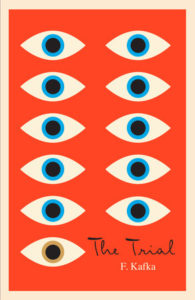
The Trial by Franz Kafka
This novel brilliantly conveys the feeling of living within an amorphous, invisible, yet all powerful bureaucracy. The individual moments are painted in great detail, while at the same time the overall picture is blurred and indefinite.
Jane Ciabattari: Kafka begins: “Someone must have been telling lies about Josef K., he knew he had done nothing wrong but, one morning, he was arrested.” After which Josef K. is subjected to a series of interrogations and hearings, always in search of what he is being accused of. The vague uncertainty that has entered his life is in sharp contrast to the violence of Kafka’s finale. How does Kafka create these effects? And how does The Trial speak to us today?
Alan Lightman: Kafka creates these effects of uncertainty and amorphous dread by having the police and the judges who arrest Joseph K never tell him what he is accused of, yet wielding undeniable power of his life, the power to arrest, the power to detain, the power to threaten with prison and worse. For me, this same kind of hidden power and surveillance is represented today by the Internet and the vast amount of data and personal information that is invisibly stored in computers. Who is to blame here? As in Kafka’s novel, it is a vast system of institutions, agencies, machines, with very few individual people who are accountable. Yet with much power over us tiny ants in the maelstrom.
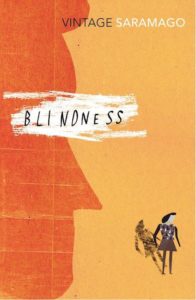
Blindness by Jose Saramago
Surrealism at its best. An entire unnamed city develops a mysterious disease causing blindness. People are reduced to their most primitive instincts and desires. The book reminds me of Lord of the Flies.
JC: And yet Saramago’s lyrical language and his characters—the first blind man, the thief who steals his car and then succumbs to the spreading epidemic of blindness, the blind doctor who treats them all as this catastrophic epidemic leads to social collapse (and whose wife who feigns blindness to stay with him as they are quarantined) and the rest are relatively civil in their interactions in comparison to Lord of the Flies. Saramago’s vision, including a line early on—“we never know what might lie in store for us”—continues to resonate. Does he create his surreal vision by a focus on the ordinary?
AL: Yes, you are right that the characters in Saramago’s novel are far more civil than those in Lord of the Flies—at least in the beginning of the epidemic. But as the novel progresses and eventually many people become quarantined and we actually see the behavior of people in the quarantined areas, the cultural veneer of civility breaks down, and we begin to see the primitive instincts of “every man for himself,” that lie deep in human nature. Saramago effectively conveys this slide into oblivion by starting with the small civilities of daily life.
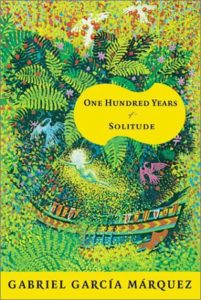
A Hundred Years of Solitude by Gabriel Garcia Marquez
The king of magic realism, Marquez is a master story teller, with this sweeping novel of several generations of a cursed family. I cannot read the book in the original Spanish, but the translation I have by Gregory Rabassa and has beautifully constructed sentences with a keen ear for rhythm, characteristic of all of Marquez.
JC: Rabassa was indeed a master. He once told me he thought of the art of translation as like jazz improvisation. A Hundred Years of Solitude has an improvisational quality, giving us chronological and cyclical time simultaneously, and concluding with a “magical” reminder the story itself exists only because we are reading it. García Márquez has acknowledged his work was influenced by Juan Rulfo, whose novel Pedro Páramo is set in a Mexican village where all the characters are dead. (García Márquez worked on a screenplay of Rulfo’s second novel, The Golden Cockerel.) How do you see García Márquez’s work in reinventing “reality” carrying forward to influence twenty-first century writers?
AL: First of all, I am impressed at your own close reading of these novels and wide erudition. So . . . kudos to you, Jane. For me, magic realism is an artifice in which we bend reality in order to see it more clearly. The challenge with magic realism (as opposed to pure fantasy) is to create realistic, believable characters, with whom the reader can identify and take seriously at an emotional level, while at the same time characters who live in a magical world, filled with ghosts and such nonreal entities. I think that many twenty-first century novelists want to break free of the traditions of the past (as each generation does) and explore new forms and techniques, while retaining the necessary amount of reality to create an emotionally powerful and believable experience for the reader. I think of Salman Rushdie, Isabelle Allende, and Haruki Murakami as falling within this category. Dave Eggers, a younger writer, has also moved in this direction.
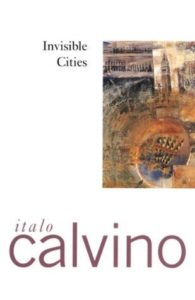
Invisible Cities by Italo Calvino
Supposedly the reports by Marco Polo to his master Ghengis Khan, each short chapter is a magical portrait of a city in the Khan’s empire. Gorgeous and poetic descriptions, abounding in metaphor. This jewel of a book was one of the inspirations for my own Einstein’s Dreams.
JC: What was your reaction when you first read Invisible Cities? How did it influence Einstein’s Dreams?
AL: When I first read Invisible Cities, I thought (and still think) it was a delicious feast of the imagination, unlike any book I’d read before. It set my own imagination on fire. Of course, I had read other magic realist writers before, like Marquez and Borges. I decided that I wanted to do for time what Calvino had done with space: create a sequence of imaginary worlds in short chapters.
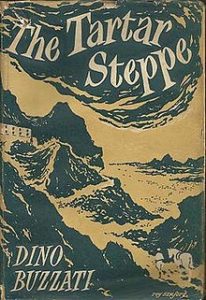
The Tartar Steppe by Dino Buzzati
A young soldier is sent to a distant outpost to guard against an invasion of his unnamed country—an invasion that never comes. As he vainly waits for glory, the soldier ages and ages and ultimately forgets the life that he once had. A powerful condemnation of the military life.
JC: We’ve come full circle, as Buzzati’s novel was influenced by The Trial. Drogo’s posting to Fort Bastiani becomes a life sentence, as he discovers “the rigid laws of army life had reached a pitch of insanity” there. Through seemingly endless years Drogo follows the rules and at times stares into the desert, seeing mirages, and the geometric shapes of the fort.
I’m reminded of a passage in your novel Three Flames. Sreypov, the youngest generation in this Cambodian family, has since age ten gone into the rice fields to look at the stars. Beginning at thirteen, she writes in her journal, which she calls Mekh or sky. “In Mekh, time didn’t flow uniformly….Present and past sometimes merged, sometimes crossed, sometimes dissolved into the future. That was the way of memories and premonitions.” She seems to be experiencing the sense of time that characterizes magical realism. Is that what you had in mind?
AL: More or less. I was also taking direction from the manner in which the Khmer Rouge genocide in Cambodia, which had a profound influence on Sreypov’s history, totally disrupted society, separating families, displacing people from their homes. Personal property was destroyed, so that many families had no remaining photographs of their parents and grandparents, thus scrambling their memories. In such a situation, it would be natural for past, present, and future to be displaced along with everything else. Finally, the individual chapters do not follow chronologically – they skip back and forth in time—following a logic of story telling rather than clock time—and I wanted that asynchronicity also to be reflected in Sreypov’s journal.
*
· Previous entries in this series ·

